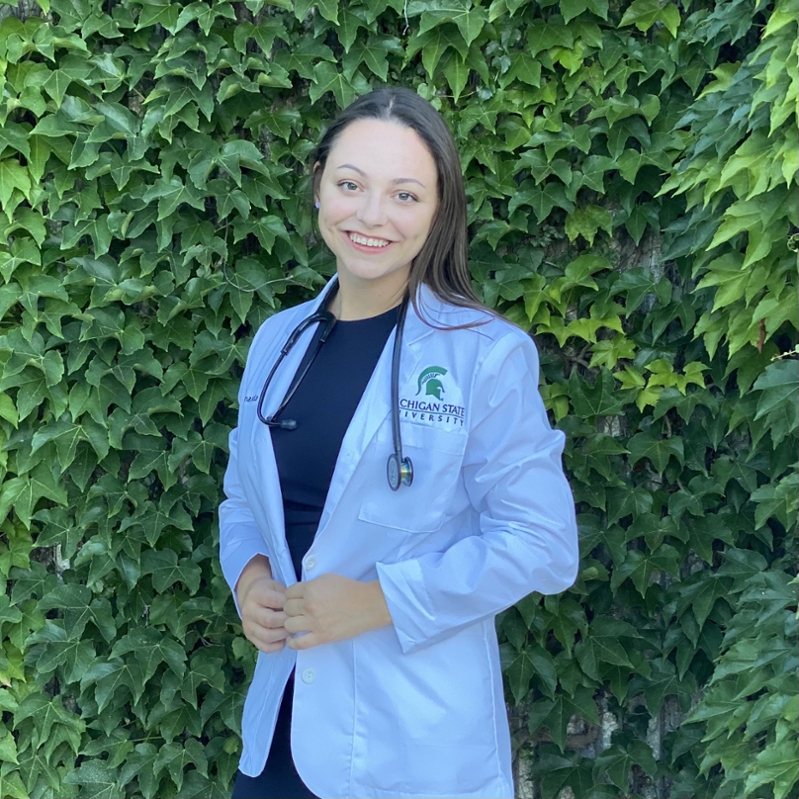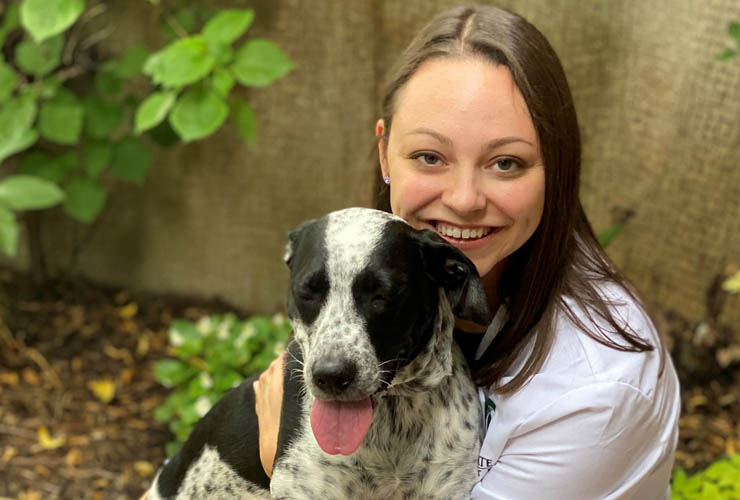Native American Heritage Month: A Student Reflection
November 23, 2021
November is Native American Heritage Month, a time to learn about rich and diverse Indigenous cultures, traditions, and histories of the land we inhabit. The College of Human Medicine acknowledges the rich ancestry of Native Americans and the important contributions of this nation’s original people, including to the processes of learning and healing.
By Amanda Ziminski, second-year College of Human Medicine student
 Aanii! Amanda indizhinikaaz, Sault Ste. Marie Tribe of Chippewa Indians indoonjbaa. (Hello! My name is Amanda and I am from the Sault Ste. Marie Tribe of Chippewa Indians).
Aanii! Amanda indizhinikaaz, Sault Ste. Marie Tribe of Chippewa Indians indoonjbaa. (Hello! My name is Amanda and I am from the Sault Ste. Marie Tribe of Chippewa Indians).
I am from a small town in Michigan’s Upper Peninsula called Manistique. I had what I consider to be a relatively normal upbringing being the third of four children in a lower-middle class family. My grandparents own a grocery store business and that’s pretty much what my family’s life revolved around. Working at the grocery store is a rite of passage in my family. We began working as soon as we hit age 14. This is where I was taught the value of hard work and independence. I also grew up with athletics shaping much of my childhood. I was active in basketball, volleyball, softball, and track. I wasn’t the greatest at these sports, being more of a witty, dry-humored, academic child, but I gave these sports my all. So, I valued being healthy in order to perform the best I could for my teams.
My earliest memory of receiving health care was from my tribe’s small Native American health care center. I’d go every year to get my sports physical so that I could play on the basketball team. It felt special to go to that clinic because my other teammates had to go to the “regular” health clinic that was conjoined to the local hospital. It wasn’t until much later that I learned how the additional struggles of receiving health care from our tiny tribal clinic would impact my health.
As a child, if there was any type of illness spreading in the community, I was destined to get it. In times where I was stressed or I was excited for an event, I would always become ill. I was sick during most of my birthday parties growing up. I also had difficulty gaining weight and always needed to carry snacks on me because my blood sugar would suddenly drop. Once I had access to specialty care later in life, I discovered what was really the cause of all of this.
It turns out I have an autoimmune disease that impacts mostly my gastrointestinal system. This explained all of my symptoms growing up, but unfortunately my condition was never caught until I was very ill while a junior in college. At MSU my access to health care expanded significantly, and I was now able to figure out what was really going on. If I had earlier access to specialty care and a doctor who knew me and my story, it could’ve prevented years of complications.
While the tribal health clinic is a great resource to many tribal members in my community (and I am certainly thankful to have it), it is largely underfunded and can only provide basic preventative care. In my experience, the physicians were different every time I went. I would see a new physician who never got to know my story or the issues that plagued me. They were not members of my tribe and were just working in the health clinic for a brief moment in time.
Additionally, the providers knew very little about autoimmune conditions or how to diagnose them. As a result, I spent years being forced to talk to nutritionists and nurses about potential eating disorders. I was instructed to take glucose tablets for when my sugar dipped too low, instead of receiving the appropriate treatment for my autoimmune condition had I been properly diagnosed.
Despite the barriers to receiving health care, I was fascinated by the doctors that I was able to see. In particular, I really looked up to the doctor I had seen in the emergency room after I had my first asthma attack. After I was stable, he came into my room and asked, “Chocolate or vanilla?”
I was confused but chose chocolate. He exclaimed “Good, because I like vanilla!”
He tossed me a chocolate pudding he got from the vending machine in the hospital and sat on the end of my bed. He handed me a spoon and opened my pudding cup for me before opening his own. He stayed there with me eating pudding, talking about my upcoming track meet, and about what was going on with my breathing. He was like one of those cool superheroes in Marvel movies.
From that moment on, I knew I wanted to be just like him when I got older. That propelled my journey into medicine.
Yet the desire to transition into a superhero ultimately became only part of the reason I wanted to become a physician. As I came to recognize the health disparities within my community, I now had a mission to ameliorate these barriers. This gave me the extra push I needed to be in the position I am in right now, feeling the massive imposter syndrome that I face as I write about my story. It gave me the push to branch out of my comfort zone and apply to a university far from home. It still propels me forward to keep going throughout the many struggles life has thrown at me.

One of those struggles has been to find my own identity. I am both white and Native American. It wasn’t until recently that I learned this challenge to define oneself is a challenge many Native Americans face. One large issue for many Native Americans is the concept of blood quantum. A blood quantum is how much Native American ancestry you contain.
Often, the first question I am asked is “How Native are you?” This is largely problematic for many reasons. Firstly, why is it that only Native Americans must quantify how much of the culture is in their blood? Many of my peers of other ethnicities are never faced with this odd question. We pride ourselves in the United States on being a cultural melting pot. When blood quantum is used to erase our ancestors from our tribe, we are also erasing the treaty rights that are rightfully ours. As our country becomes more and more of a cultural melting pot, our treaty rights are being ripped away from our people with this concept of blood quantum. It is a concept that hurts many Native Americans as it is designed to make us feel less Indigenous and less like we belong.
Being the only Native American in my matriculating class sometimes can be difficult. In my undergrad, I was the co-chair of the North American Indigenous Student Organization (NAISO). I felt a great sense of community through that organization. Being on my own now without students who share my culture has been lonely at times. While there is a Latinx and Native American Medical Student Association (LANAMA) that has gone above and beyond to make me feel welcomed as one of few Native persons, I still yearn for that sense of community I once had—a community with which to share struggles when it comes to being a Native American pursuing medicine.
For many Native American students pursuing medicine, we are the first. We are the first in our families and even communities, at times, to attend college. We are the first to take the MCAT, apply to medical school, navigate financial aid, etc. We often don’t have people in our corners that can help guide us. Since we are the first to pursue this route, there is an immense pressure to succeed so that we can open doors for others. There is also always an intense pressure to be the advocate for our people. For if we don’t, who will?
Being Native American while in medical school can also be frustrating. We are taught in medical school about the health disparities that exist within certain groups of people. We analyze it and discuss it in detail. We are assigned projects and readings on it. Still, the struggle in accessing health care for Native American communities isn’t always as front and center.
Through a quick Google search you can find directly on the Indian Health Service website (a part of the U.S. government) that Native Americans and Alaskan Natives continue to perish from many diseases at higher rates than any other group. Yet, Native Americans are often left entirely out of the conversation when it comes to race and disparities.
This, to me, is why Native American Heritage Month is important. It is a time to remember exactly whose land you own.
It is a time to remember that Native Americans are not just fictional characters of the past, but that we are still here. It is a time to celebrate Native American history and all of us that are here today and continue to persevere.

